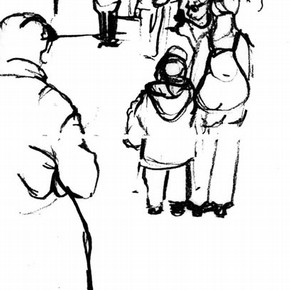Conservation Journal
October 1997 Issue 25
Postcards From Paris
Paris! Ah, the city of romance and art, Gene Kelly and Cyd Cherise, good food and good wines, but not for us. We were in search of conservation, students eager to learn, to broaden our horizons, to understand foreign ways. Preservation our watchword. Education our raison d'être.
Monday saw a party divided. Some headed for l'Orangerie, to see the Monets and other jewels of Impressionist art, then subsequently got lost in Pigalle and Montmartre! The others, led astray by William, visited lots of skeletons in the cupboards (the anthropological collections), at the Musée de l'Homme, which is under threat from Presidential plans to take the science out of Ethnology and replace it with a Museum of Civilisations and Fine Arts. Heads were rolling, some from guillotine victims, others from Napoleonic soldiers, others from a need for careful cushioning.
No trip to Paris would be complete without a look at the fashions, so on Tuesday we went to the Musée de la Mode et du Costume. Mme Antoinette Villa gave us a tour of the conservation studios and the impressive 4000 sq. m. of modern textile storage space, the largest in Europe.
Later, we separated for visits to the Gobelins Tapestry Workshops and Père Lachaise cemetery. Montmartre had cast its spell over Nick, drawing him to its artistic heart as he worked on the practical art of his research with sketchbook and palette. Sixteenth century François Clouet miniatures at the Louvre also kept him busy as he compared them with Hilliards. We all met at the end of the day at the Musée D'Orsay.
Wednesday was a day for paper and history. At the Bibliothèque Nationale de France, M. Thierry Aubry presented his work on a sixteenth century edition of a Qur'an, attacked by verdigris and insects. Damaged bindings had been replaced allowing flexibility and giving strength. Following this we toured the studios, science lab and gilding workshops. In the afternoon were were welcomed at the Musée Carnavalet paper conservation studio by Mme Beatrice Liebard and Mme Christiane Gregorie. We were particularly interested in the extensive use of light bleaching, for which a special cupboard had been constructed. We also studied fan conservation before collapsing, exhausted, in a nearby café.
Thursday (Anna's Birthday!)
The treasures of the Ancient East were brought close to us at the Musée Guimet. Mme Feugère and her colleagues showed us tenth Century scrolls and seventh century temple banners in amazing condition and we discussed their conservation treatment in depth. M. Cailleteau, the paper conservator, enlightened us further about the most appropriate methods of conserving ancient Chinese texts. We were interested to note that Japanese methods of conservation, such as wet lining, are not favoured here. After lunch at the Foreign Office canteen with our hosts, we dispersed. Some went shopping, others went to see even more culture at the Grand Palais and the Musée du Moyen Age. If, on our final evening we had hoped to listen to some modern jazz in one of the hip bars around the Bastille, we were disappointed: we were not allowed in, supposedly because of overcrowding...
Friday, we had a few hours to spare before catching the train back to London, so we dashed out to the studios of the Service de Restauration des Musées de France. There was a moment of panic when a train strike threatened to keep us in Paris but we persevered and made it back to the V&A!
The Conservation students would like to thank Sarah Dodman of the RCA for dealing with logistics, all the people within the Parisian institutions for their time and expertise and Helen Jones and Alan Cummings for their organisation and company.
October 1997 Issue 25
- Editorial
- Hearing the Original Instrument
- Preparations for 'Carl and Karin Larsson: Creators of the Swedish Style'
- Showcases - An External Perspective
- Pollution Monitoring Within the Historic Royal Palaces
- Conservation on the Internet: Practicalities and Possibilities
- Questions and Answers: Review of 'The Interface Between Science and Conservation'
- Conservation Under the Microscope: Two Reviews of RCA/V&A Conservation 1997
- Postcards From Paris
- Printer Friendly Version
